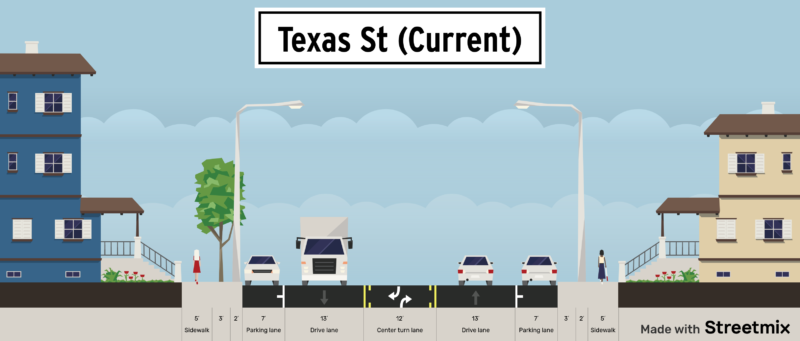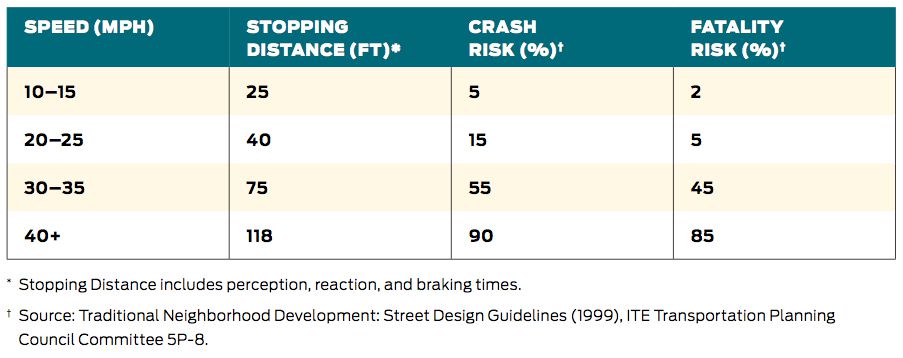A Vision for Texas Street
By Nevo Magnezi, BikeSD Board Secretary
On August 18, 2019, Tom Morris, a man with a walker, was killed due to traffic violence while trying to cross Texas St in North Park. On November 17 of the same year, a 33-year old man was killed, also trying to cross Texas St, this time by a big rig truck. They join 6,590 other Americans who were killed in 2019, doing something that comes naturally to all of us: getting around on foot. Indeed, 2019 saw the highest pedestrian fatality rate in the United States since 1988.
Other cities in developed countries don’t seem to have this issue. Oslo and Helsinki saw zero pedestrian deaths in 2019. This success is not because our Nordic friends are less likely to jaywalk. Rather, it is because urban planners in those places design their built environment to be safer and more forgiving to human error. The tired excuses that San Diego is so distinct from other places that we must simply accept the killing of our community members cannot be tolerated. We can and must do better to make our entire transportation system safer.
So what makes Texas Street so deadly? Between wide streets, heavy traffic, insufficient pedestrian crossings, and a complete lack of any biking infrastructure, Texas Street is not designed for humans in mind.

As city planners know well, speed kills. The National Association of City Transportation Officials, or NACTO, recommends that lane widths be 10 feet in urban areas to reinforce a 25mph speed limit, or 11 feet for designated bus and truck routes such as Texas St. The current distance from the edge of the street parked cars and the line delineating the center turn lane is 14 feet. The city must reinforce a design that truly limits vehicle speeds to 25mph, and that means ensuring lanes are only as wide as their intended use.

With two 11 foot vehicle lanes, the pedestrian crossing distance, should naturally be no more than 22 feet. By implementing mini-roundabouts, as done on Meade Ave, in conjunction with pedestrian refuge islands and curb extensions, the pedestrian crossing distance can be reduced to 11 feet at intersections. Furthermore, raised continental crosswalks implemented at every intersection could further increase the visibility of pedestrians and provide much needed mobility to disabled folks who currently cannot cross at many of the intersections.

With each vehicle lane width of 11 feet and 7-8 feet for street parking, that leaves 16 feet left on this 52 foot wide street. We believe that the best use of the remainder of the street width would be for two 8 foot wide cycletracks, including buffer, adjacent to the curb. Similar designs of sandwiching cycletracks between the sidewalk and street parking have successfully been implemented in many other cities as well as downtown. We note that the North Park Community plan calls for a class II bike lane facility, which makes sense, as in addition to being a bus, truck, vehicle, and pedestrian route between North Park and Mission Valley, Texas Street is also a bike route and has class II bike lanes north of Madison Avenue. That being said, we believe a class IV cycletrack is more appropriate for Texas street between Madison Avenue & University Ave because of the NACTO recommendation that streets with a speed of 25mph and an average daily traffic volume of greater than 6,000 vehicles be equipped with protected bike lanes, in order to become a facility suitable for all ages and abilities.
Finally, we would like to note that we think it would be great to keep the approximately 98 public street parking spaces, according to our count, on Texas St between Madison Avenue and El Cajon Boulevard, as well as points south. Parked cars can further provide protection and limit speeds by making the lane feel even narrower to drivers, and offer convenience to those who drive in the neighborhood. However, our top priorities must be satisfying our vision zero and climate action plan goals. Ultimately, we defer to the expertise of our city planners in determining how much street parking can be maintained.
No doubt, building roundabouts, protected bike lanes, and extending curbs will be costly. While BikeSD is not qualified in estimating the total cost, it is worth noting that in 2013, the state of California determined the economic loss associated with each traffic violence death to be 1.32 million dollars. With two deaths and twenty five reported injuries since the beginning of 2018, building a safer Texas Street will be a steal in comparison to doing nothing. The state provides funding for jurisdictions to build complete streets through SB-1, however so far the city has not used any of that money explicitly for that purpose. We ask that the City of San Diego use all available funding sources, including SB-1, in order to ensure that Texas Street becomes safe for users of all ages and abilities.

